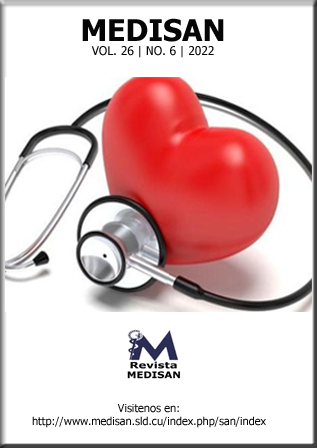Comorbilidades y factores asociados en pacientes con alopecia areata
Palabras clave:
alopecia areata, comorbilidades, factores de riesgo, atención secundaria de salud.Resumen
Introducción: La alopecia areata en una enfermedad autoinmune caracterizada por la pérdida no cicatricial de pelo; puede ser catalogada como un problema estético, sin tener en cuenta que tiene alto impacto en la calidad de vida de quien la padece.
Objetivo: Identificar las comorbilidades, el impacto psicosocial y los factores asociados en pacientes con alopecia areata.
Métodos: Se realizó un estudio observacional, descriptivo y transversal de 50 pacientes con diagnóstico clínico de alopecia areata, atendidos en el Hospital General Docente Dr. Juan Bruno Zayas Alfonso de Santiago de Cuba, desde 2018 hasta 2020.
Resultados: En la casuística prevalecieron los pacientes de 29-39 años de edad (46,0 %), el sexo masculino (58,0 %), el estrés y la ansiedad como factores emocionales (76,0 %), seguidos de los focos sépticos (40,0 %); el nivel de escolaridad de técnico medio (52,0 %), el estado civil acompañado (44,0 %) y el tiempo de evolución de la alopecia entre 4 y 12 meses (76,0 %).
Conclusiones: Se evidenció que la mayoría de los pacientes presentaron algún episodio emocional o una crisis de ansiedad, previos al inicio de la alopecia areata.
Descargas
Citas
2. Manzur katrib J, Díaz Almeida JG, Cortés Hernández M, Ortiz González PR, Sagaró Delgado B, Abreu Daniel A, et al. Dermatología. La Habana: Editorial Ciencias Médicas; 2002. p. 1 – 22.
3. Lee S, Lee YB, Kim BJ, Lee WS. Screening of thyroid function and autoantibodies in patients with alopecia areata: A systematic review and meta-analysis. J Am Acad Dermatol. 2019 [citado 11/10/2022];80(5):1410-3. Disponible en: https://www.sciencedirect.com/science/article/abs/pii/S0190962218328883
4. Strazzulla LC, Chun Wang EH, Avila L, Sicco KL, Brinster N, Christiano AM, et al. Alopecia areata: disease characteristics, clinical evaluation, and new perspectives on pathogenesis. J Am Acad Dermatol. 2018 [citado 11/10/2021];78(1):1-12. Disponible en: https://www.sciencedirect.com/science/article/abs/pii/S019096221731873X
5. Dainichi T, Kabashima K. Alopecia areata: what’s new in epidemiology, pathogenesis, diagnosis, and therapeutic options? J Dermatol Sci. 2017 [citado 28/10/2021];86(1):3-12. Disponible en: https://www.sciencedirect.com/science/article/abs/pii/S0923181116308416
6. Welsh O. Phototherapy for alopecia areata. Clin Dermatol. 2016 [citado 11/10/2021];34(5):628-32. Disponible en: https://www.sciencedirect.com/science/article/abs/pii/S0738081X1630150X
7. Li J, van Vliet C, Rufaut NW, Jones LN, Sinclair RD, Carbone FR. Laser capture microdissection reveals transcriptional abnormalities in alopecia areata before, during, and after active hair loss. J Invest. Dermatol. 2016;136(3):715-8.
8. Torales JC, Malatesta EM, González LL, González IA, López RD, Barrios JI, et al. Psicodermatología: una introducción a sus conceptos, nosología y modelos de abordaje. An Fac Cienc Méd. (Asunción). 2020 [citado 11/10/2021];53(2):127-36. Disponible en: https://observatorio.fm.usp.br/bitstream/OPI/38136/1/art_TORALES_Psicodermatologia_una_introduccion_a_sus_conceptos_nosologia_y_2020.PDF.pdf
9. Fernández Rodríguez JC, Miralles Muñoz F, Millanas Cuevas L. Alopecia areata y personalidad: estado de su relación a través de una revisión bibliográfica. RICS. 2019 [citado 11/10/2021];8(15):19-39. Disponible en: https://www.rics.org.mx/index.php/RICS/article/view/78/303
10. Salazar Nieves M. Calidad de vida en las alopecias e influencia de la relación médico paciente. Alcoy: 3Ciencias; 2017.
11. Ranpariya RH, Gupta SB, Deora MS, Agrawal PV, Mathur R, Raheja A. Intralesional triamcinolone acetonide versus platelet rich plasma: a comparative study in the treatment of alopecia areata of scalp. Int J Res Dermatol. 2019 [citado 11/10/2021];5(3):521-7. Disponible en: https://www.ijord.com/index.php/ijord/article/view/697/379
12. Rodgers AR. Why finding a treatment for alopecia areata is important: a multifaceted perspective. J Invest Dermatol Symposium Proceedings. 2019 [citado 11/10/2021];19(1):51-3. Disponible en: https://www.sciencedirect.com/science/article/pii/S1087002417300412
13. Garcia Melendo C, Cubiró X, Puig L. Janus kinase inhibitors in dermatology: part 1—general considerations and applications in vitiligo and alopecia areata. Actas Dermosifiliogr. 2021 [citado 11/10/2021];112(6):503-15. Disponible en: https://www.sciencedirect.com/science/article/pii/S1578219021001499
14. FIvenson D. COVID‐19: association with rapidly progressive forms of alopecia areata. Int J Dermatol. 2021 [citado 11/10/2021];60(1):127. Disponible en: https://www.ncbi.nlm.nih.gov/pmc/articles/PMC7753616/pdf/IJD-60-127.pdf
15. Toussi A, Barton VR, Le ST, Agbai ON, Kiuru M. Psychosocial and psychiatric comorbidities and health-related quality of life in alopecia areata: A systematic review. J Am Acad Dermatol. 2021 [citado 11/10/2021];85(1):162-75. Disponible en: https://www.sciencedirect.com/science/article/abs/pii/S0190962220311440
16. Suchonwanit P, Kositkuljorn C, Pomsoong C. Alopecia areata: an autoimmune disease of multiple players. ImmunoTargets Ther. 2021 [citado 11/10/2021];10:299-312. Disponible en: https://www.ncbi.nlm.nih.gov/pmc/articles/PMC8328385/pdf/itt-10-299.pdf
17. Zhou C, Li X, Wang C, Zhang J. Alopecia areata: an update on etiopathogenesis, diagnosis, and management. Clinic Rev Allerg Immunol. 2021;61(3):403-23.
18. Sterkens A, Lambert J, Bervoets A. Alopecia areata: a review on diagnosis, immunological etiopathogenesis and treatment options. Clin Exp Med. 2021;21:215-30.
19. Senna M, Ko J, Tosti A, Edson Heredia E, Fenske DC, Ellinwood AK, et al. Alopecia areata treatment patterns, healthcare resource utilization, and comorbidities in the US population using insurance claims. Adv Ther. 2021 [citado 11/10/2022];38:4646-58. Disponible en: https://link.springer.com/article/10.1007/s12325-021-01845-0
20. Mostaghimi A, Napatalung L, Sikirica V, Winnette R, Xenakis J, Zwillich SH, et al. Patient perspectives of the social, emotional and functional impact of alopecia areata: a systematic literature review. Dermatol Ther (Heidelb). 2021 [citado 11/10/2022];11:867-83. Disponible en: https://link.springer.com/article/10.1007/s13555-021-00512-0
Publicado
Cómo citar
Número
Sección
Licencia
Esta revista provee acceso libre e inmediato a su contenido bajo el principio de que hacer disponible gratuitamente investigación al público, apoya aún más el intercambio de conocimiento global. Esto significa que los autores/as conservarán sus derechos de autor y garantizarán a la revista el derecho de primera publicación de su obra, el cuál estará simultáneamente sujeto a la licencia internacional Creative Commons Atribución 4.0 que permite copiar y redistribuir el material en cualquier medio o formato para cualquier propósito, incluso comercialmente, además de remezclar, transformar y construir a partir del material para cualquier propósito.





